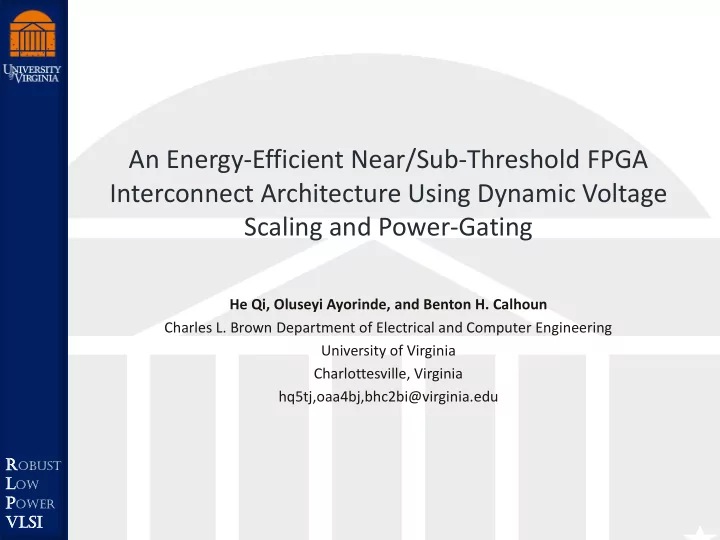

An Energy-Efficient Near/Sub-Threshold FPGA Interconnect Architecture Using Dynamic Voltage Scaling and Power-Gating He Qi, Oluseyi Ayorinde, and Benton H. Calhoun Charles L. Brown Department of Electrical and Computer Engineering University of Virginia Charlottesville, Virginia hq5tj,oaa4bj,bhc2bi@virginia.edu R obust L ow P ower VLSI
Motivation By 2020, there will be more than 50 billion electronic devices in total and 6.58 per person connected to internet. https://encrypted-tbn1.gstatic.com/images?q=tbn:ANd9G cQCNBXqIdhnsSVYp4y1A4MnKeoVOVfLomVOqtyQT-wQRZij_sy7 Source: Evans, Dave. "The internet of things: How the next evolution of the internet is changing everything." CISCO white paper 1 (2011): 1-11. The majority of these electronic devices will be Low-power sensors in Ubiquitous Computing. • Health Sensors • Environmental Sensors http://www.valencell.com/blog/2013/12/wearable-technology-all- 2 about-people
Motivation Requirements on Hardware • Low Power/Energy Consumption FPGAs meet all of these • Substantial Processing Capability requirements. • Flexible Hardware • Low Development and Deployment Cost ULP FPGAs for Sensors Existing LP FPGAs The power of existing LP FPGAs exceed the energy budget of sensor applications. Solution • ULP FPGA operating in sub/near-threshold 3
Background FPGA Energy Breakdown ➢ The interconnect dominates FPGA delay & energy. ➢ To reduce energy, we proposed an low- swing interconnect in our prior work by removing buffers and properly sizing the circuits at near/sub-threshold. Low-Swing Interconnect Our low-swing interconnect is proved to be 42.7% lower energy than a traditional uni- directional interconnect at 0.4V. However, energy waste still exist in the low-swing interconnect. 4
Problems Energy Waste in Low-Swing Interconnect • Energy Waste #1 : Attaching circuits on non-critical paths to the same supply voltage of circuits on critical paths is a waste of energy. Observations • The delay of the non-critical paths is unnecessarily small. Reducing the supply voltage of circuits on non-critical paths saves energy without affecting the overall FPGA speed. 5
Problems Energy Waste in Low-Swing Interconnect • Energy Waste #2 : The interconnect resources that are in idle mode consume a lot of leakage energy, especially in sub-threshold region. Observations • Implementing the showing benchmarks, over 40% of the total FPGA energy is wasted in the form of idle circuit leakage. • The idle circuit leakage energy mostly comes from configuration bitcells. 6
Problems Typical Solutions • Dual-VDD : apply a lower VDD to the circuits on non-critical paths • Power-Gating : cut off the connections between the idle circuits and supply voltages using headers. However • Due to the large area overhead, no existing work applied dual-VDD to the traditional Interconnect. • No existing work applied Power-Gating to configuration bitcells. Observation • The low-swing interconnect enables dual-VDD. 7
Contributions Contributions • We applied dual-VDD technique to the low-swing FPGA interconnect at near/sub-threshold. • We applied power-gating technique to the idle configuration bitcells. • We developed a new dynamic voltage scaling architecture for low-swing interconnect. • We designed a power management unit enabling dual-VDD and DVS. Tasks • SPICE Simulation • Energy Saving Evaluation • Overhead Evaluation • Tool Development • Chip Measurement of a Custom 512-LUT FPGA 8
Proposed Architecture • The VDDH & VDDL are generated by a LDO, along with the headers to perform dual-VDD and power-gating. • The VDDC is generated by a delay-chain-based control logic to perform DVS. 9
Proposed Architecture Details of the delay-chain-based control logic Step 1 : The delay chains generate a bitstream pattern D0D1 … Dn based on the system clock frequency. Step 2 : The control circuit converts this bistream into control bits that turning on/off the header switches of each VDDC value. 10
Methodology Step 1 : low-swing interconnect modelling Dual-VDD Assignment Flow & SPICE sims at different supply voltages. Step 2 : benchmark routing info generation using VPR Step 3 : dual-VDD assignment and energy reduction estimation using custom tool Step 4 : energy reduction estimation of power-gating and DVS 11
Results --- Dual-VDD Observations • The optimal VDDL in terms of energy is obtained at 0.1V lower than VDDH. • The energy reduction of using dual-VDD is about 20% on average, but reduces to about 10% when considering voltage regulator overhead. 12
Results --- Dual-VDD & Power-Gating Coarse-Grained Power-Gating 𝑊 𝐸𝐸 < 5% area overhead Switch Box Fine-Grained Power-Gating 𝑊 𝑊 𝐸𝐸 𝐸𝐸 bitcell bitcell 14% area Switch Box overhead 𝑊 𝑊 𝐸𝐸 𝐸𝐸 bitcell bitcell Observations • Using coarse-grained power-gating & dual-VDD together with considering voltage regulator overhead, the energy reduction reaches 17.5 ~ 21.9%. If using fine-grained power-gating, the energy reduction reaches 43.7 ~ 62.2%. • The measurement results of a custom 512-LUT FPGA shows an 91.1% leakage energy reduction using coarse-grained power-gating itself. 13
Results --- DVS Observations • For APEX2 at 0.6V, by sweeping VDDC from VDD to 0.7V higher than VDD, the critical path delay can be adjusted in the range of 0.22us ~ 0.43us, while the total FPGA energy per operation can be adjusted in the range of 21.9pJ ~ 35.7pJ. 14
Conclusions Contributions • We applied dual-VDD technique to the low-swing FPGA interconnect at near/sub-threshold with tool support. • We applied power-gating technique to the idle configuration bitcells. • We developed a new dynamic voltage scaling architecture for low-swing interconnect. • We designed a power management unit enabling dual-VDD and DVS. Limitations & Future work • Dual-VDD: We haven’t developed a tool for configuring dual-VDD on chips. We have no measurement results for dual-VDD so far. • Power-Gating: We haven’t optimized the layout of switch boxes using fine-grained power-gating. • Benchmarks: We haven’t evaluate the proposed architecture using IoT applications 15
Thank you! Questions? 16
Backup Slides 17
Noise & Crosstalk 18
Benchmark Characterization 19
Comparisons with Prior Art 20
Recommend
More recommend